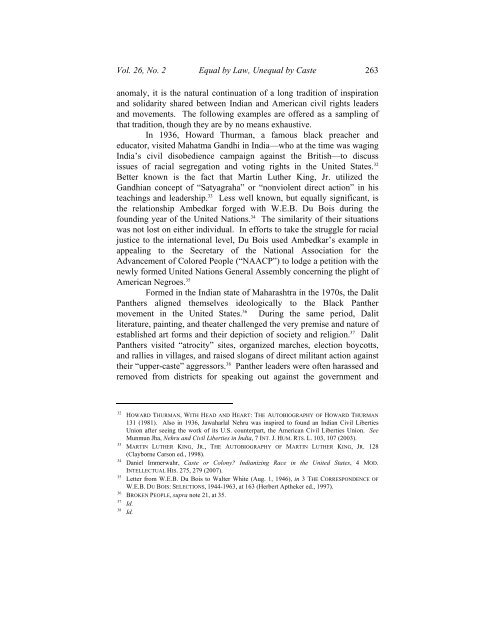262 Wisconsin <strong>International</strong> Law Journalcompensate for past injustices or as a means to level a playing field tiltedin favor of whites and “upper-<strong>caste</strong>” Hindus. Indian judges have oftencited U.S. affirmative action decisions and <strong>law</strong> review articles in theiropinions, although U.S. case <strong>law</strong> has not been cited as legal precedent.Indian Supreme Court Justice Matthew in the 1975 case State of Keralav. Thomas noted the following in reference to the landmark U.S. caseBrown v. Board of Education:Beginning most notably with the U.S. Supreme Court’scondemnation of school segregation in 1954, the U.S. has finallybegun to correct the discrepancy between its ideals and its treatmentof the black man . . . . These actions, while not producing true<strong>equal</strong>ity or even <strong>equal</strong>ity of opportunity logically dictated the nextstep: positive use of government power to create the possibility ofreal <strong>equal</strong>ity. 30It comes as no surprise that the richness of the field ofcomparison has invited critical and thoughtful comparative legalscholarship on the Indian and American experience with affirmativeaction. 31 Less well-considered are the contemporary struggles faced <strong>by</strong>both movements to counter the mechanisms and rhetoric through whichthe objectives of that legal framework now stand to be defeated. Thenarrative of oppression, and of racist and <strong>caste</strong>ist denial, is strikinglysimilar from continent to continent and each country’s <strong>equal</strong>ity project isdecidedly unfinished for similar reasons.Inviting American scholars and advocates to turn to India and thelessons it offers to illuminate their own racial justice project is not an3031State of Kerala v. Thomas, 1976 S.C.R. 906 (1975). See also Justice Harlan’s famous dissent inPlessy v. Ferguson, the very case that affirmed the ‘separate but <strong>equal</strong>’ doctrine: “in [the] viewof the Constitution, in the eye of the <strong>law</strong>, there is in this country no superior, dominant, rulingclass of citizens. There is no <strong>caste</strong> here. Our Constitution is color-blind.” 163 U.S. 537, 559(1896) (emphasis added).See, e.g., Laura Dudley Jenkins, Race, Caste and Justice: Social Science Categories andAntidiscrimination Policies in India and the United States, 36 CONN. L. REV. 747 (2004)(examining the role of social science in the categorization of race and <strong>caste</strong> for affirmative actionpurposes in India and the U.S., focusing on both the census and the courts); Clark D.Cunningham, After Grutter Things Get Interesting! The American Debate Over AffirmativeAction Is Finally Ready for Some Fresh Ideas from Abroad, 36 CONN. L. REV. 665, 665-66(2004) (arguing that U.S. affirmative action programs can be informed <strong>by</strong> lessons learned fromIndia and France, focusing specifically on India’s delineation of groups for different levels ofpreference); Jason Morgan-Foster, Note, From Hutchins Hall to Hyderabad and Beyond: AComparative Look at Affirmative Action in Three Jurisdictions, 9 WASH. & LEE RACE & ETHNICANC. L.J. 73, 73-75 (2003) (examining differences and similarities between American, Indian,and European systems of affirmative action); Kevin D. Brown, African-Americans Within theContext of <strong>International</strong> Oppression, 17 TEMP. INT’L & COMP. L.J. 1 (2003) (providing aprimarily personal account comparing the experience of African-Americans to the struggle of<strong>Dalit</strong>s and of black South Africans, based on his travel experiences to both countries).
Vol. 26, No. 2 Equal <strong>by</strong> Law, Un<strong>equal</strong> <strong>by</strong> Caste 263anomaly, it is the natural continuation of a long tradition of inspirationand solidarity shared between Indian and American civil rights leadersand movements. The following examples are offered as a sampling ofthat tradition, though they are <strong>by</strong> no means exhaustive.In 1936, Howard Thurman, a famous black preacher andeducator, visited Mahatma Gandhi in India—who at the time was wagingIndia’s civil disobedience campaign against the British—to discussissues of racial segregation and voting rights in the United States. 32Better known is the fact that Martin Luther King, Jr. utilized theGandhian concept of “Satyagraha” or “nonviolent direct action” in histeachings and leadership. 33 Less well known, but <strong>equal</strong>ly significant, isthe relationship Ambedkar forged with W.E.B. Du Bois during thefounding year of the United Nations. 34 The similarity of their situationswas not lost on either individual. In efforts to take the struggle for racialjustice to the international level, Du Bois used Ambedkar’s example inappealing to the Secretary of the National Association for theAdvancement of Colored People (“NAACP”) to lodge a petition with thenewly formed United Nations General Assembly concerning the plight ofAmerican Negroes. 35Formed in the Indian state of Maharashtra in the 1970s, the <strong>Dalit</strong>Panthers aligned themselves ideologically to the Black Panthermovement in the United States. 36 During the same period, <strong>Dalit</strong>literature, painting, and theater challenged the very premise and nature ofestablished art forms and their depiction of society and religion. 37 <strong>Dalit</strong>Panthers visited “atrocity” sites, organized marches, election boycotts,and rallies in villages, and raised slogans of direct militant action againsttheir “upper-<strong>caste</strong>” aggressors. 38 Panther leaders were often harassed andremoved from districts for speaking out against the government and32333435363738HOWARD THURMAN, WITH HEAD AND HEART: THE AUTOBIOGRAPHY OF HOWARD THURMAN131 (1981). Also in 1936, Jawaharlal Nehru was inspired to found an Indian Civil LibertiesUnion after seeing the work of its U.S. counterpart, the American Civil Liberties Union. SeeMunmun Jha, Nehru and Civil Liberties in India, 7 INT. J. HUM. RTS. L. 103, 107 (2003).MARTIN LUTHER KING, JR., THE AUTOBIOGRAPHY OF MARTIN LUTHER KING, JR. 128(Clayborne Carson ed., 1998).Daniel Immerwahr, Caste or Colony? Indianizing Race in the United States, 4 MOD.INTELLECTUAL HIS. 275, 279 (2007).Letter from W.E.B. Du Bois to Walter White (Aug. 1, 1946), in 3 THE CORRESPONDENCE OFW.E.B. DU BOIS: SELECTIONS, 1944-1963, at 163 (Herbert Aptheker ed., 1997).BROKEN PEOPLE, supra note 21, at 35.Id.Id.
- Page 1 and 2: EQUAL BY LAW, UNEQUAL BY CASTE: THE
- Page 3 and 4: Vol. 26, No. 2 Equal by Law, Unequa
- Page 5 and 6: Vol. 26, No. 2 Equal by Law, Unequa
- Page 7: Vol. 26, No. 2 Equal by Law, Unequa
- Page 11 and 12: Vol. 26, No. 2 Equal by Law, Unequa
- Page 13 and 14: Vol. 26, No. 2 Equal by Law, Unequa
- Page 15 and 16: Vol. 26, No. 2 Equal by Law, Unequa
- Page 17 and 18: Vol. 26, No. 2 Equal by Law, Unequa
- Page 19 and 20: Vol. 26, No. 2 Equal by Law, Unequa
- Page 21 and 22: Vol. 26, No. 2 Equal by Law, Unequa
- Page 23 and 24: Vol. 26, No. 2 Equal by Law, Unequa
- Page 25 and 26: Vol. 26, No. 2 Equal by Law, Unequa
- Page 27 and 28: Vol. 26, No. 2 Equal by Law, Unequa
- Page 29 and 30: Vol. 26, No. 2 Equal by Law, Unequa
- Page 31 and 32: Vol. 26, No. 2 Equal by Law, Unequa
- Page 33 and 34: Vol. 26, No. 2 Equal by Law, Unequa
- Page 35 and 36: Vol. 26, No. 2 Equal by Law, Unequa
- Page 37 and 38: Vol. 26, No. 2 Equal by Law, Unequa
- Page 39 and 40: Vol. 26, No. 2 Equal by Law, Unequa
- Page 41 and 42: Vol. 26, No. 2 Equal by Law, Unequa
- Page 43 and 44: Vol. 26, No. 2 Equal by Law, Unequa
- Page 45 and 46: Vol. 26, No. 2 Equal by Law, Unequa
- Page 47 and 48: Vol. 26, No. 2 Equal by Law, Unequa
- Page 49 and 50: Vol. 26, No. 2 Equal by Law, Unequa
- Page 51 and 52: Vol. 26, No. 2 Equal by Law, Unequa
- Page 53 and 54: Vol. 26, No. 2 Equal by Law, Unequa
- Page 55: Vol. 26, No. 2 Equal by Law, Unequa
- Page 58 and 59:
312 Wisconsin International Law Jou
- Page 60 and 61:
314 Wisconsin International Law Jou
- Page 62 and 63:
316 Wisconsin International Law Jou
- Page 64 and 65:
318 Wisconsin International Law Jou
- Page 66 and 67:
320 Wisconsin International Law Jou
- Page 68 and 69:
322 Wisconsin International Law Jou
- Page 70 and 71:
324 Wisconsin International Law Jou
- Page 72 and 73:
326 Wisconsin International Law Jou
- Page 74 and 75:
328 Wisconsin International Law Jou
- Page 76 and 77:
330 Wisconsin International Law Jou
- Page 78 and 79:
332 Wisconsin International Law Jou
- Page 80 and 81:
334 Wisconsin International Law Jou
- Page 82 and 83:
336 Wisconsin International Law Jou
- Page 84 and 85:
338 Wisconsin International Law Jou
- Page 86 and 87:
340 Wisconsin International Law Jou
- Page 88 and 89:
342 Wisconsin International Law Jou
















